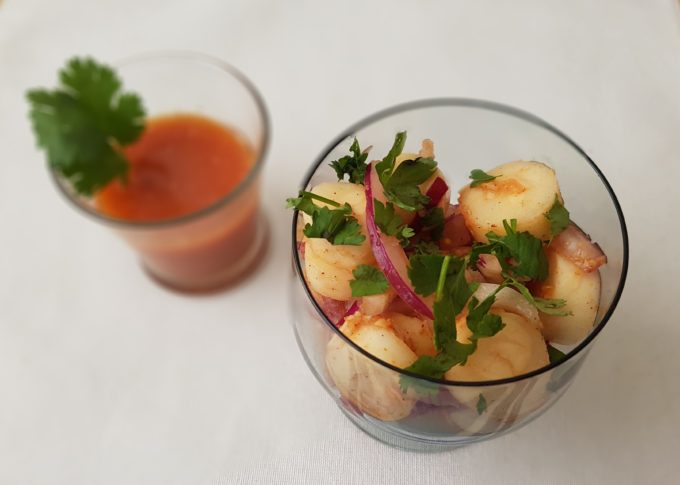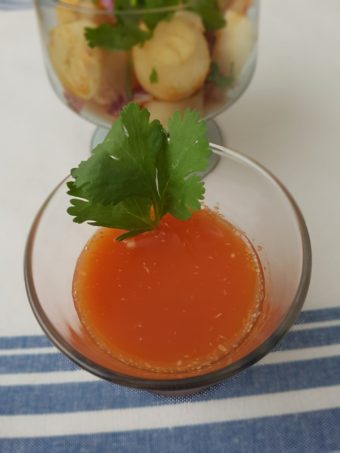 Ceviche is a traditional dish made using an acid, typically a citrus juice, to marinade raw fish. It is believed to date back to the Incan Empire, but with so much immigrating in and out of the area, and the basic-ness of the idea, it’s pretty unrealistic to allow one civilization full credit. There were certainly Moorish influences mixed in with the Spanish Conquistador culture that conquered the Inca, and ceviche is not that unique from Japanese sashimi. Then there is the kinilaw of the Philippines, in which raw fish is marinaded in a fermented vinegar, typically coconut.
Ceviche is a traditional dish made using an acid, typically a citrus juice, to marinade raw fish. It is believed to date back to the Incan Empire, but with so much immigrating in and out of the area, and the basic-ness of the idea, it’s pretty unrealistic to allow one civilization full credit. There were certainly Moorish influences mixed in with the Spanish Conquistador culture that conquered the Inca, and ceviche is not that unique from Japanese sashimi. Then there is the kinilaw of the Philippines, in which raw fish is marinaded in a fermented vinegar, typically coconut.
 Origins aside, this particular recipe has been created with traditional Peruvian favors in mind. The annatto seed, called achiote in Spanish, is common among the Amazonian Peruvians, Brazilians, and Ecuadorians. I would suggest using seville, or bitter orange juice, but for ease the recipe below uses naval orange, grapefruit, and lime juices. They sell naranja agria, seville orange juice, in the Latin section of our international market, however, it’s loaded with a lot of extra junk. I felt that ‘more natural’ won-out over ‘more traditional’ this time.
Origins aside, this particular recipe has been created with traditional Peruvian favors in mind. The annatto seed, called achiote in Spanish, is common among the Amazonian Peruvians, Brazilians, and Ecuadorians. I would suggest using seville, or bitter orange juice, but for ease the recipe below uses naval orange, grapefruit, and lime juices. They sell naranja agria, seville orange juice, in the Latin section of our international market, however, it’s loaded with a lot of extra junk. I felt that ‘more natural’ won-out over ‘more traditional’ this time.
Speaking of tradition, the common chili for this marinade would be fresh rocoto chili. This is a red chili pepper with a heat index similar to cayenne or de arbol. Again, to simplify things I went with a ground chili, picking aji amarillo, another Peruvian favorite. Pick a fresh or ground chili that works for you, and, obviously, spice it to your personal desire.
The last, and probably most obvious ingredient would be the fish. Above all else, you want to pick the freshest fish you can find. The citrus helps to break down the proteins, but it does not kill bacteria or viruses that may be present. Firm white fish like halibut, sole, and flounder work best, but you could also choose shark or tuna. For the vegetarians and vegans, as I have pictured here, you can substitute hearts of palm for cebiche de palmito, or banana flower, which is common in the Philippines.
As for sides, in Peru it is most often served with corn; grilled corn on the cob, roasted corn nut-like kernals, and/or popped corn. Chiffles (plantian chips), avocados, mangoes, and rice are also very common.
The last, and perhaps most interesting aspect of eating ceviche would be drinking the leche de tigre, ‘Tiger’s Milk.’ This is the tradition of serving the marinading juices, after marinading, in a small glass as a beverage either before or with the meal. ¡Salud!
Annatto Ceviche Marinade
By: Semiserious Chefs
Serves: 3-4 large portions; 6 as a side dish
Ingredients:
- 1 pound of cubed fresh white fish of choice. See notes above.
- OR one 14.5 oz can of hearts of palm; drained and chopped
- OR one banana blossom; sliced
- half of a medium red onion; sliced or diced as prefered
- 1/4 cup orange juice; ~1/2 a navel orange
- 1 T lime juice
- 1 T grapefruit juice
- 1 T ginger, finely minced or micro-planed
- 1 large garlic clove; finely minced or micro-planed
- 1/2 t ground annatto
- 1/4 t aji amarillo; to taste
- OR cayenne or de arbol
- 1/4 salt; or more to taste
- chopped fresh cilantro
If you plan to serve the leche de tigre, you will probably need to multiply the marinading ingredients by the number of people drinking. …but I highly suggest it!
Directions:
- You can soak the red onions in some water while you prep the rest of the ingredients. It’s not required, but it will tone down their flavor if you prefer.
- Add the citrus juices to the fish, and allow to sit for at least 5 minutes, until the meat becomes white and opaque. This is a bit of a moot step for a vegetarian/vegan choice.
- Now add the drained onions, ginger, garlic, annatto, ground chili, and salt. Mix well.
- Plate each dish with a generous serving of fresh cilantro, to taste.

Post a comment